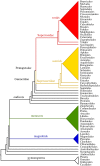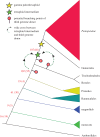Evolution of floral diversity: genomics, genes and gamma
- PMID: 27994132
- PMCID: PMC5182423
- DOI: 10.1098/rstb.2015.0509
Evolution of floral diversity: genomics, genes and gamma
Abstract
A salient feature of flowering plant diversification is the emergence of a novel suite of floral features coinciding with the origin of the most species-rich lineage, Pentapetalae. Advances in phylogenetics, developmental genetics and genomics, including new analyses presented here, are helping to reconstruct the specific evolutionary steps involved in the evolution of this clade. The enormous floral diversity among Pentapetalae appears to be built on a highly conserved ground plan of five-parted (pentamerous) flowers with whorled phyllotaxis. By contrast, lability in the number and arrangement of component parts of the flower characterize the early-diverging eudicot lineages subtending Pentapetalae. The diversification of Pentapetalae also coincides closely with ancient hexaploidy, referred to as the gamma whole-genome triplication, for which the phylogenetic timing, mechanistic details and molecular evolutionary consequences are as yet not fully resolved. Transcription factors regulating floral development often persist in duplicate or triplicate in gamma-derived genomes, and both individual genes and whole transcriptional programmes exhibit a shift from broadly overlapping to tightly defined expression domains in Pentapetalae flowers. Investigations of these changes associated with the origin of Pentapetalae can lead to a more comprehensive understanding of what is arguably one of the most important evolutionary diversification events within terrestrial plants.This article is part of the themed issue 'Evo-devo in the genomics era, and the origins of morphological diversity'.
Keywords: Gunneridae; Pentapetalae; eudicots; floral evolution; gamma palaeohexaploidy.
© 2016 The Author(s).
Figures



References
-
- Anon. 2013. The plant list v1.1. See http://www.theplantlist.org/ (accessed 1 January 2016).
-
- The Angiosperm Phylogeny Group 2016. An update of the Angiosperm Phylogeny Group classification for the orders and families of flowering plants: APG IV. Bot. J. Linn. Soc. 181, 1–20. (10.1111/boj.12385) - DOI
Publication types
MeSH terms
Associated data
LinkOut - more resources
Full Text Sources
Other Literature Sources

